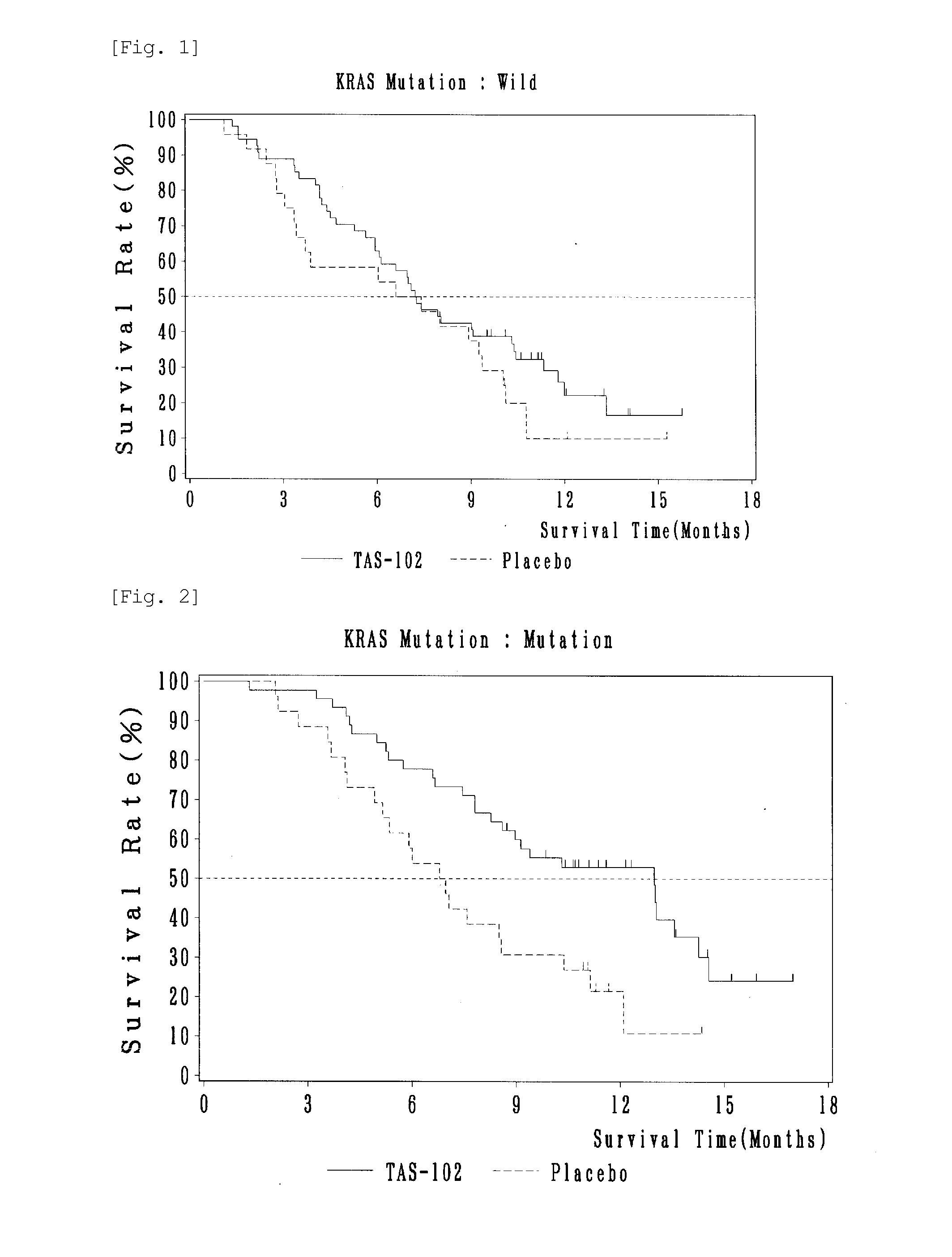Antitumor agent and therapeutic effect prediction method for patients with kras-mutated colorectal cancer
a colorectal cancer and agent technology, applied in the direction of immunoglobulins, peptides, drug compositions, etc., can solve the problems of insufficient effective chemotherapies, limited choice of antitumor agents that can significantly prolong the survival of colorectal cancer patients with kras gene mutations, and insufficient therapeutic effects, so as to prolong the survival of colorectal cancer patients, improve the effect of tas-102 and prolong the survival
- Summary
- Abstract
- Description
- Claims
- Application Information
AI Technical Summary
Benefits of technology
Problems solved by technology
Method used
Image
Examples
example 1
[0051]Progressive recurring colorectal cancer patients (169 cases) who are refractory or intolerant to standard therapy including 5-FU, irinotecan, and oxaliplatin, and who have a treatment history of at least 2 regimens, are divided into a TAS-102 administration group (112 cases) and a placebo group (57 cases). There was no significant background difference between these two groups (including percentage of male patients (TAS-102 administration group, 57.1%; placebo group, 49.1%), average age (TAS-102 administration group, 63; placebo group, 62), ECOG PS 0 (TAS-102 administration group, 64.3%; placebo group, 61.4%), and percentage of the patients having a treatment history of 3 or more regimens (TAS-102 administration group, 84.8%; placebo group, 77.2%)). In the TAS-102 administration group, during the 4-week administration course, TAS-102 was administered twice a day in an FTD amount of 70 mg / m2 (per body surface area) / day from Day 1 to Day 5 and from Day 8 to Day 12. This adminis...
example 2
[0057]Next, in order to verify the usability of TAS-102 with respect to the KRAS gene mutation-type colorectal cancer patients, an in vivo efficacy test was performed in a nude mouse subcutaneously transplanted with a human colorectal cancer strain.
[0058]TAS-102 was orally administered to nude mice transplanted with human colorectal cancer strain HCT-116, which is known as a KRAS mutation-type, twice a day for 14 consecutive days in an FTD amount of 150 mg / kg / day by an ordinary method (TAS-102 Administration Group). Further, as a comparative group, cetuximab, which is often clinically used for colorectal cancer patients who are refractory or intolerant to standard therapy including 5-FU, irinotecan, and oxaliplatin, was intraperitoneally administered in an amount of 40 mg / kg / day on Day 1, Day 5, Day 8, and Day 12 (this administration amount is confirmed for the antitumor effect in other cancers). In contrast, no drug was administered in the control group. The antitumor effect was ev...
PUM
| Property | Measurement | Unit |
|---|---|---|
| Refractory | aaaaa | aaaaa |
Abstract
Description
Claims
Application Information
 Login to View More
Login to View More - R&D
- Intellectual Property
- Life Sciences
- Materials
- Tech Scout
- Unparalleled Data Quality
- Higher Quality Content
- 60% Fewer Hallucinations
Browse by: Latest US Patents, China's latest patents, Technical Efficacy Thesaurus, Application Domain, Technology Topic, Popular Technical Reports.
© 2025 PatSnap. All rights reserved.Legal|Privacy policy|Modern Slavery Act Transparency Statement|Sitemap|About US| Contact US: help@patsnap.com


